Squirrel: It’s What’s for Dinner Bushy-Tailed Mammals Make for a Nutritious and Sustainable Meal
Published November 2nd, 2023 at 3:00 AM
Above image credit: Six-year-old Lilliah didn't care for the taste of squirrel, but hopes to be a veterinarian some day. She was thrilled at the opportunity to see the insides of an animal at the Squirrel Clinic. "I want to be an animal doctor when I grow up and this is a step towards being an animal doctor," she said. (Cami Koons | Flatland)LAWRENCE, Kansas — A line formed around a conference table as folks helped themselves to bowls of roasted and stewed squirrel.
The rich, braised aroma made the Delaware Street Commons gathering space especially warm and inviting for dozens of people who traversed a chilly autumn rain to learn about a curious confection.
For many, it was their first time tasting the small, wild game animal. Plenty went back for seconds.
The meal closed a community event about the ethics and methods of trapping, preparing and cooking the bushy-tailed “chickens of the trees” that pervade urban and suburban neighborhoods.
While perhaps an unconventional food source to some, squirrels were once a common source of meat. In rural areas, it continues to be a favorite among some hunters.
But since the 1970s, the number of squirrels harvested in Kansas has plummeted, according to data from the Kansas Department of Wildlife and Parks.

As a result, squirrel populations have grown. Indeed, the small animals have become nuisances for many people as urban sprawl shrinks their wild habitats.
Amy Bousman, KC District Education Specialist with the Kansas Department of Wildlife and Parks, organizer of the Saturday event, said there’s not a squirrel problem, but a human problem. She said hunting again is a way to balance the relationship between the “human animals” and the squirrels.
“That’s the whole purpose of a conservation office,” Bousman said.
Folks attended the Saturday Squirrel Clinic, hosted by Bousman and the department, for various reasons. Most had an interest in fostering a deeper connection with their local environment and living more sustainably by consuming locally.
“Not only is wild nutrition what our bodies are meant for but being able to obtain place-based wild nutrition … reduces my carbon footprint,” Bousman said.
‘If You Can’t Beat ‘Em, Eat ‘Em’
This is the second clinic of this kind that Bousman has hosted.
Over the summer she taught a group of urban farmers at New Roots for Refugees how to trap, process and eat the groundhogs that had been tormenting their crops.
It was a successful program. Bousman said refugee populations, non-western cultures especially, find it more normal to eat small game like this. And in lower-income neighborhoods it’s a cost-effective way to get nutrient-dense protein.
Anil Kamat, a friend of Bousman’s and neighbor of the Delaware Street Commons community in east Lawrence, heard of the groundhog clinic and reached out to Bousman to see if a similar event could help with the squirrels that kept robbing his chicken feed.

For Kamat, who was pestered by the squirrels, Bousman said it’s a situation of, “If you can’t beat ‘em, eat ‘em.”
She was eager to host the clinic and get more folks interested in the wild game during Kansas’s long squirrel season, which runs from June through February.
“Squirrel is one of my favorite things to hunt and eat,” Bousman said.
She especially wanted to bring the knowledge and skills to communities who value sustainable and equitable consumption and who want to be more connected to their food systems.
“This is kind of a steppingstone activity,” Bousman said. “(People) don’t have to purchase a firearm or learn how to use it to trap.”
Kansas residents are required to have a general hunting license (and pass a hunter’s safety course) to hunt squirrels.
Before her role at the department of wildlife, Bousman worked as a nutritional therapy practitioner. Squirrels can replace chicken in most recipes and are much more nutrient dense and lean.
Bousman encourages folks to connect with their food at all levels, and hosts workshops on foraging and entomology (insects) in the Kansas City region. A number of folks brought their children to the clinic on Saturday, which Bousman was excited about as it normalizes being connect to our animal food sources.
On Sunday, Nov. 19, the department is hosting its first Wild Foods Cookoff at the Baker Wetlands in Lawrence to highlight wild nutrition. Competing dishes can feature anything from wild fish, invasive species, mushrooms, venison and of course, squirrels.
Leading up to the Squirrel Clinic, Bousman taught Kamat and a neighbor how to set a live trap for the critters and she let them at it. Each caught several squirrels, which they dispatched (killed) and froze in preparation for the clinic.

From Tree to Plate
Eating “place-based” wild foods, as Bousman called them, can be a wonderful way to decrease one’s carbon footprint and grow closer to their food. Hunting a squirrel out of the backyard, she explained, is even better than buying organic, pasture-raised chicken breasts that were grown states away and processed, packaged and shipped to the grocery store.
“When you procure your own wild game, you’re a part of the process,” Bousman said. “For (westerners) foods that we turn our noses up to are normal across the rest of the planet … What’s not normal is being so disconnected from your food source.”
Consuming local foods and being more connected to the process are values shared by Kamat and Laura Odell, a Delaware Street Commons neighbor who helped to trap squirrels for the workshop.
“In a way, it’s actually brought us closer,” Odell said of the process and her relationship to the squirrels in her neighborhood.
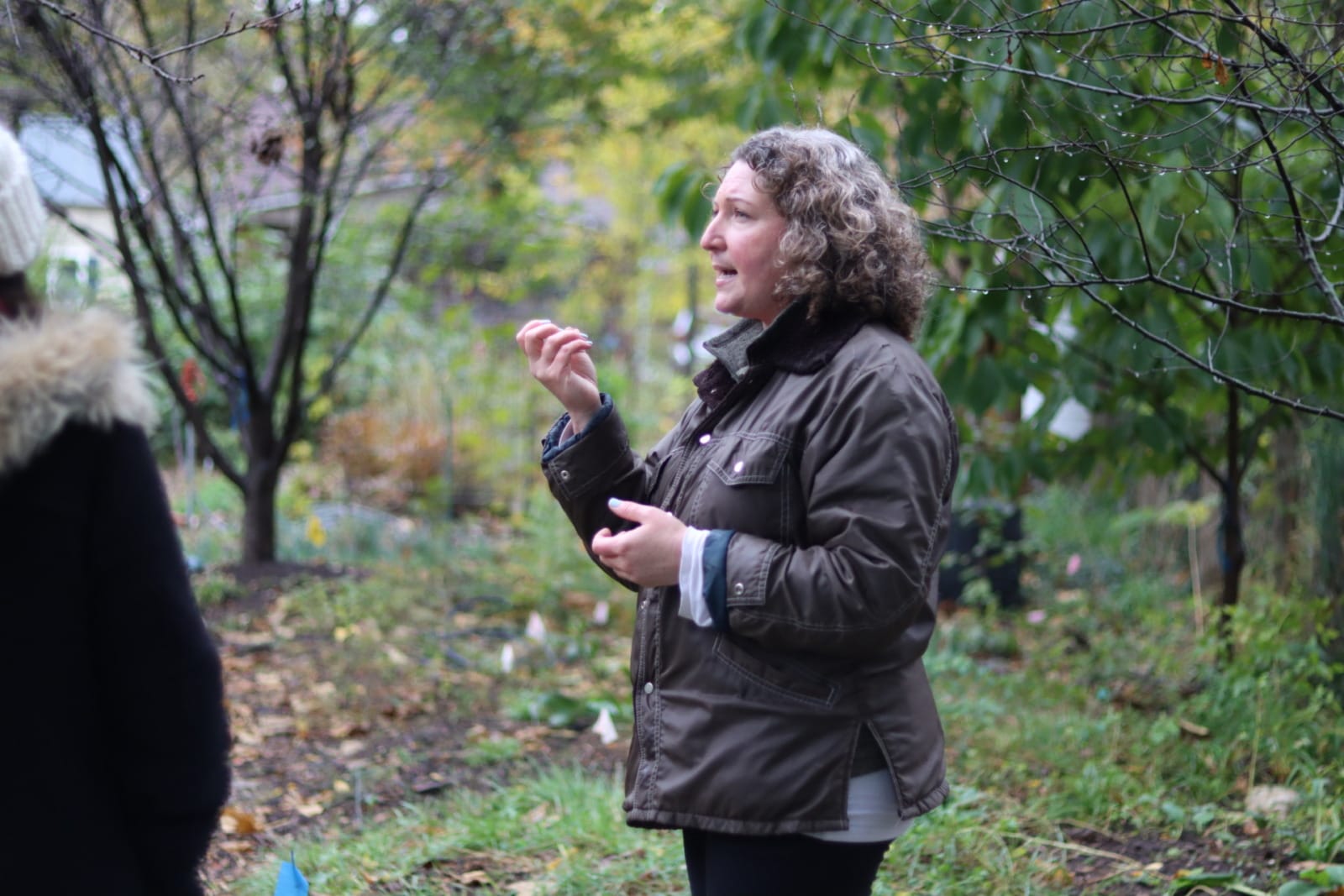
Odell maintains a permaculture community orchard down the street from her home at Delaware Street Commons, a like-minded co-housing community. She became interested in controlling the squirrel population when she felt an imbalance in her orchard. Squirrels were nabbing fruit from the trees before they were even fully ripe.
“This is part of the harvest,” Odell said and laughed that the squirrels she caught have been raised on the delicious, organic fruit from her orchard. “This is very relevant to maintaining a food forest.”
Bousman taught folks at the clinic how to easily hunt and harvest squirrels within city limits (where it is illegal to discharge any projectile):
- Observe areas in the yard where squirrels frequent and set a live trap. The department of wildlife has a stash it can loan out to interested Kansans. (Odell and Kamat used peanut butter and bread as bait in the traps.)
- Monitor the traps and try to attend to trapped squirrels within an hour or so to limit their panic.
- Submerge the entire trap in a sufficiently large bin of water for several minutes. Wear thick gloves while handling the traps. (The animal stills after about 15 seconds under water.)
- Begin to clean the animal, or bag and move to the freezer to process later.
- Wearing sterile gloves and using clean, sharp blades, snip off the squirrel paws at the joint.

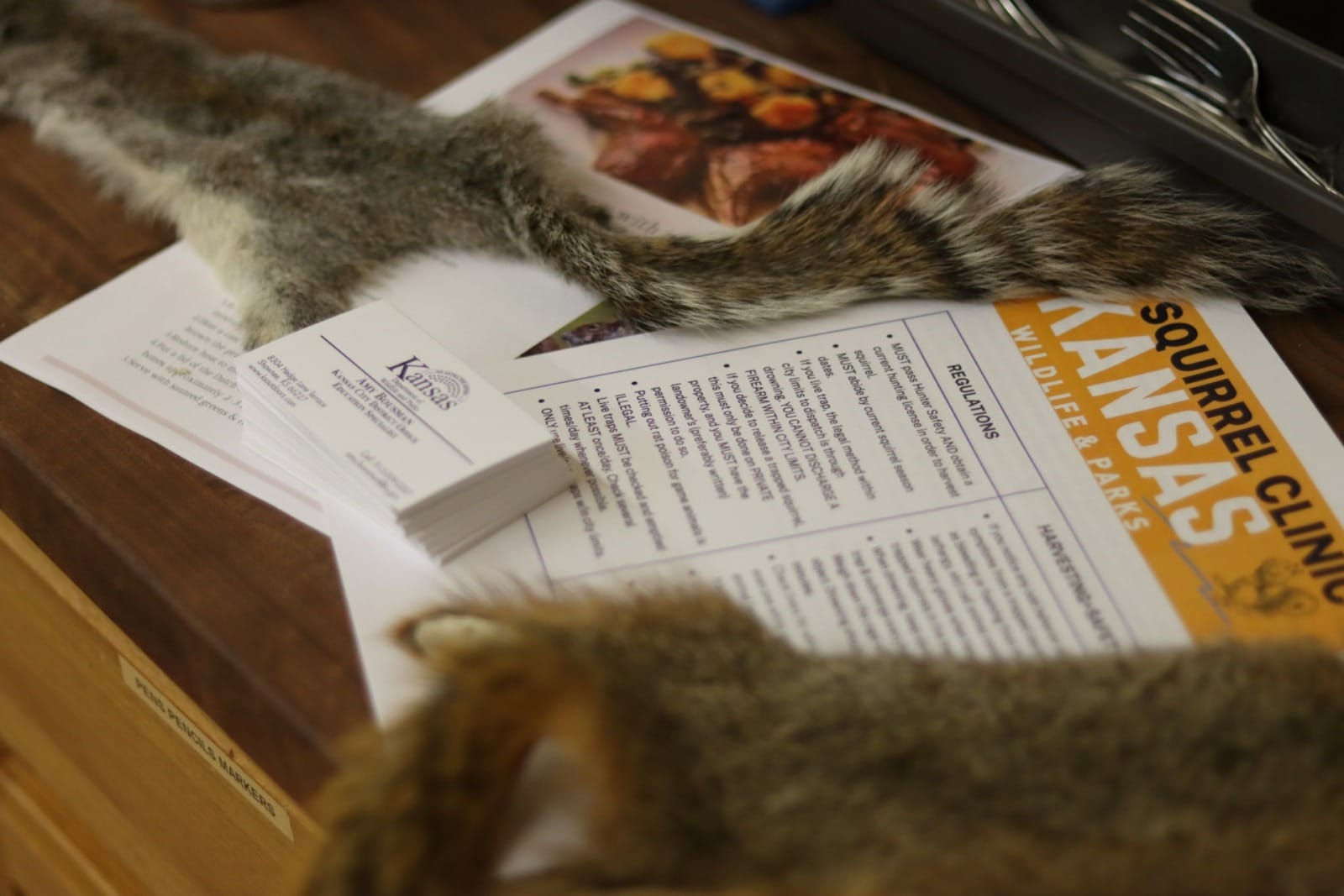
- Make a small incision through the skin perpendicular to the spine of the squirrel, continuing all the way around the belly and back. (This is the easiest method to skin but isn’t great for keeping/using the pelts.)
- Use fingers and small sweeping motions with a blade to peel the skin back from the flesh, working from the center down to the paws until you can pull the fur off “like a sock.” Do the same thing on the other half, stopping at the head, which can be snipped off at the neck.
- Open the stomach. Be careful not to puncture any organs.
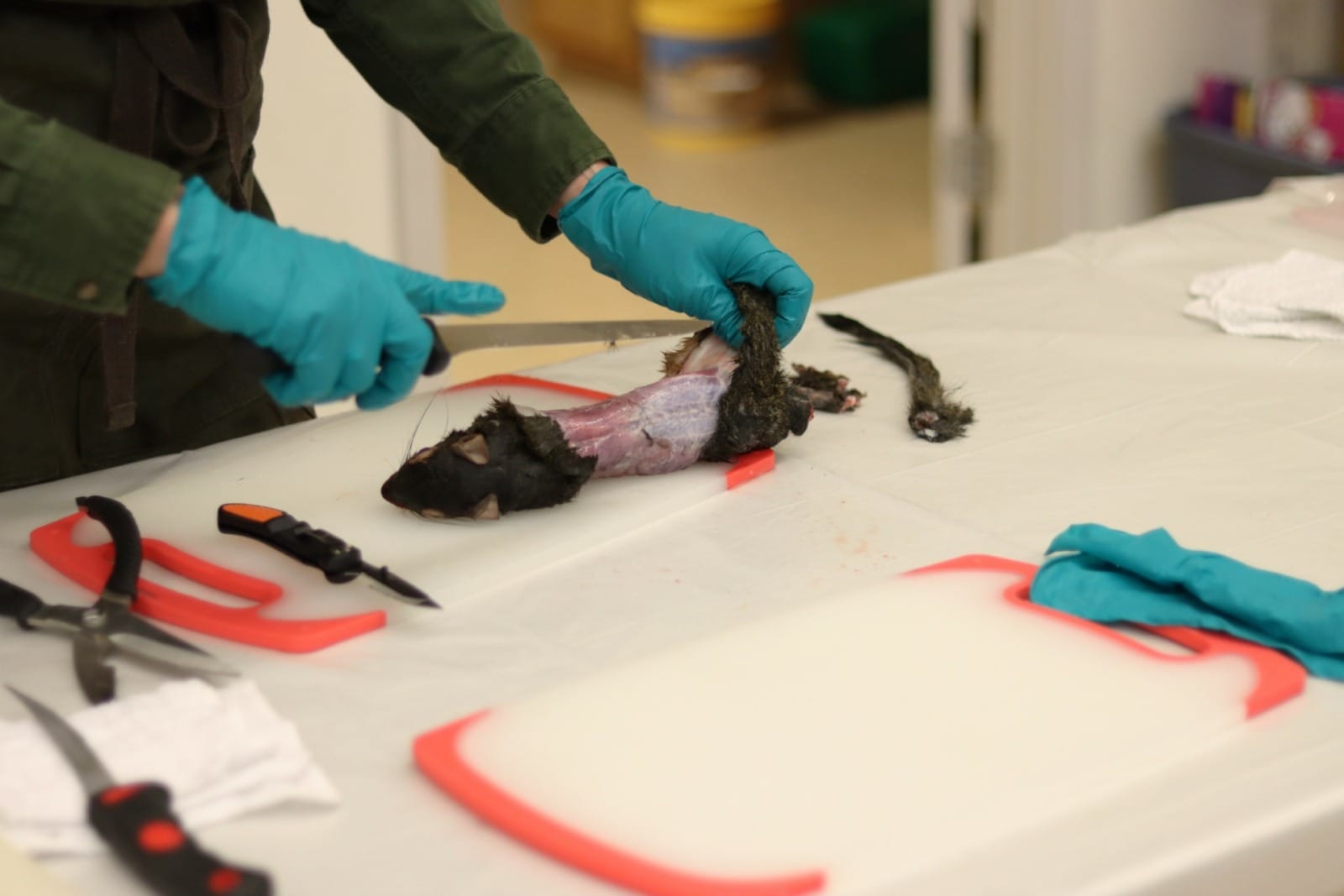
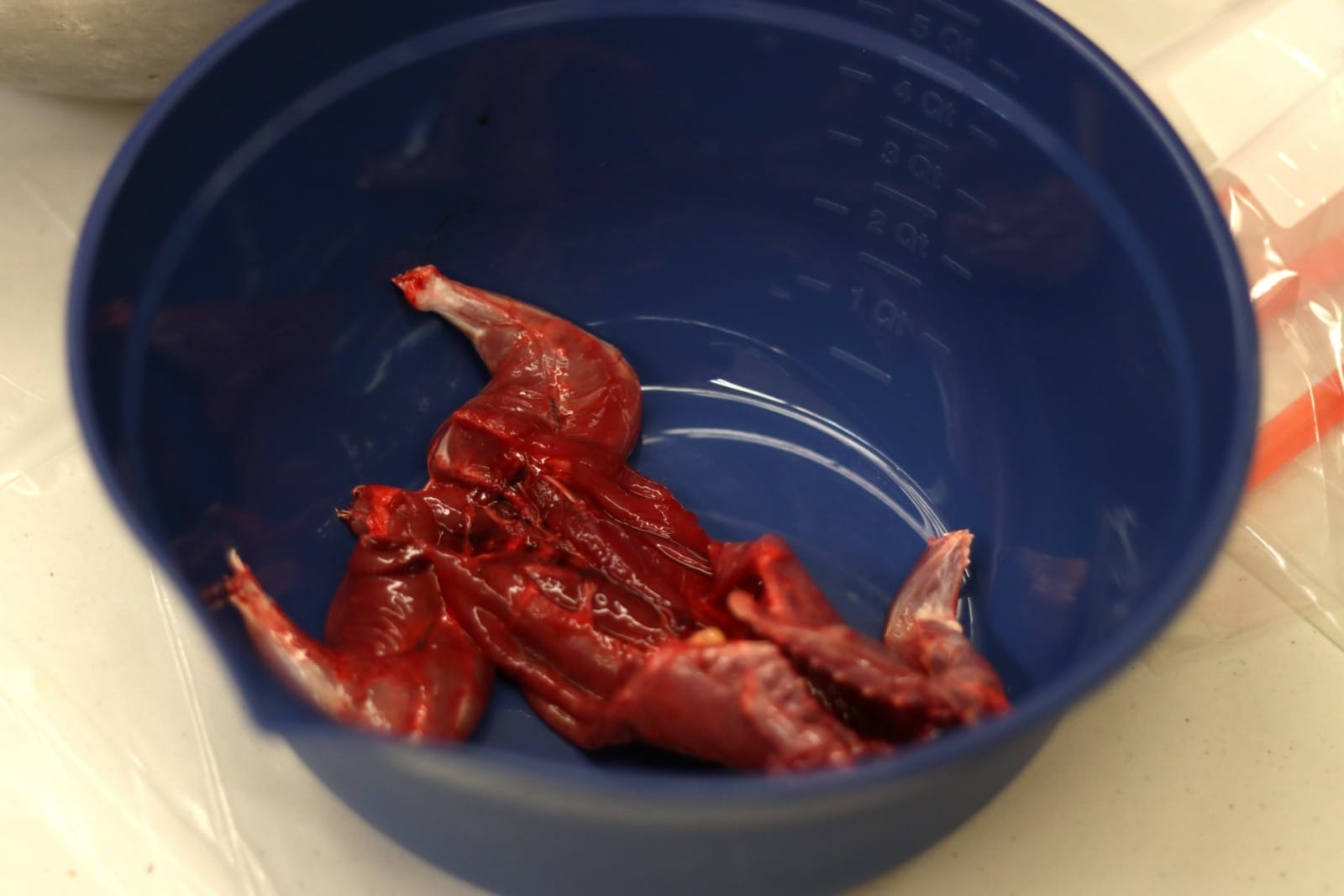
- Locate the liver and inspect for any abnormalities. White spots on the liver could be a sign of tularemia, a disease found in small mammals. It’s fairly rare, especially if hunting in the cooler months, but Bousman’s advice is, “When in doubt, throw it out.” (This goes for any other abnormalities like blood clots, tapeworms, or external lesions on the squirrel.)
- Remove the rest of the guts, including the lungs and heart. Bousman suggests folks cook the heart and liver (after cutting out the gallbladder) for their nutrients.
- Slice through the pelvis and sternum to butterfly the squirrel and better fit it in a cooking vessel.
- Thoroughly rinse with clean water.
- Cook “low and slow” for tender, flavorful meat.
Bousman, a self-proclaimed “hippie who hunts,” offered many ethical considerations throughout the program, like choosing live traps over paw or body traps which could ensnare a pet or child. She also encouraged folks to give gratitude for the animal’s life and the nourishment it provided.
Kamat, who harbors no resentment towards the critters who steal his chicken feed, said for each of the five squirrels he trapped, he fed them a last meal (a cashew or piece of beer-soaked bread) and said a few words of thanks before dispatching them.
At the Saturday event, Bousman had several squirrels set aside for demonstrations and she allowed interested attendees to try their hand at skinning and cleaning the animals.
Hara Aramaya volunteered enthusiastically. They had attended a foraging event earlier this year hosted by Bousman and were drawn to her ethical approach to local foods.
“She really cares,” Aramaya said. “She brings the honor. It’s really important to me for humans to have the right connection (to food).”
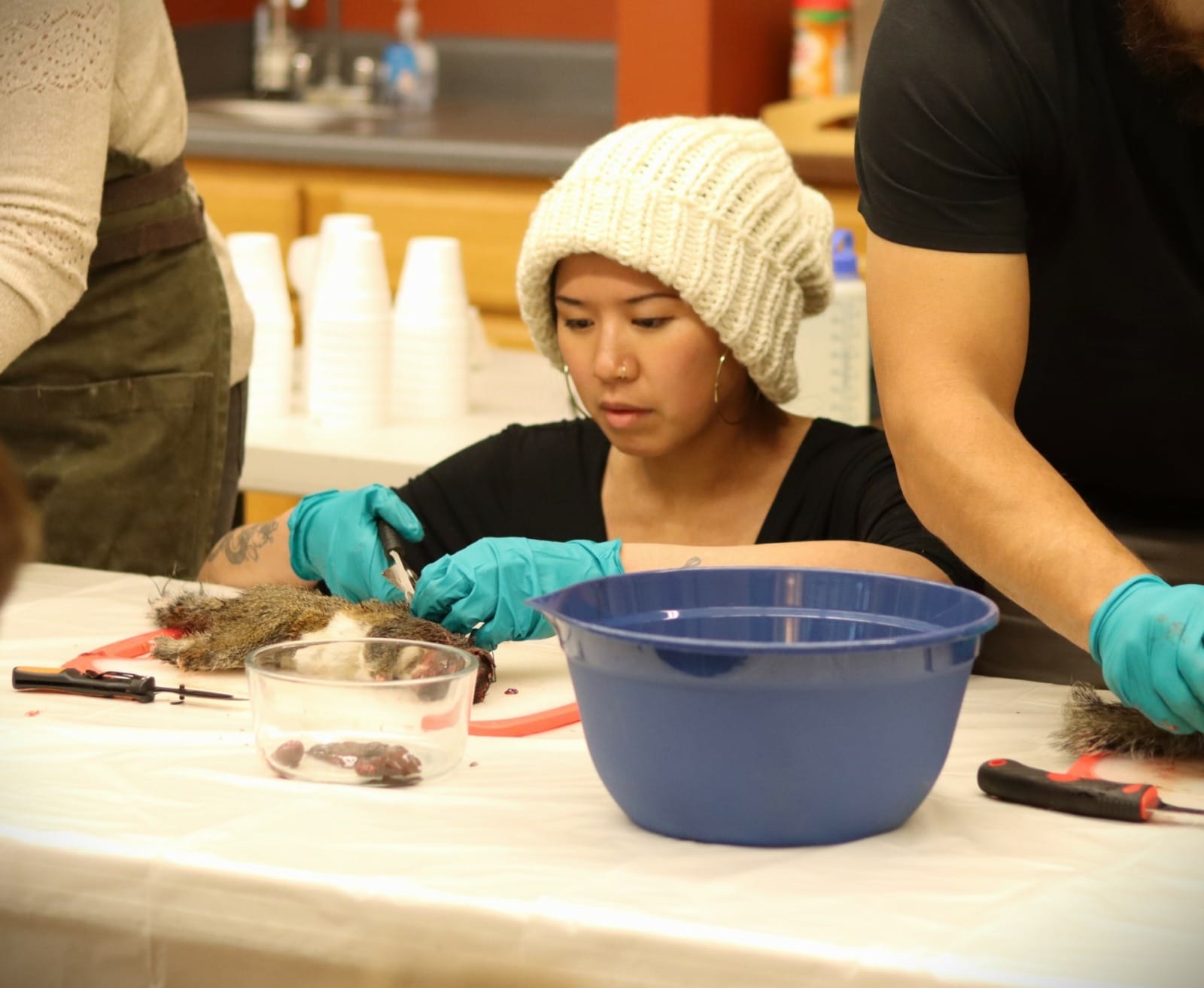
Aramaya followed Bousman’s instructions and took the squirrel from a furry animal to something that looked like meat.
“It definitely made me feel very connected and just have gratitude for the animals that provide us sustenance,” Aramaya said afterwards while they enjoyed a bowl of the squirrel stew prepared by Odell and Kamat.
It’s hard to have the same level of appreciation for an animal’s life when it comes in a plastic package at the grocery store, they noted.
Aramaya came to the clinic with their fiancé, Gabriel Rose, who watched intently and shed a few tears of appreciation as Aramaya skinned the squirrel.
“The whole time I was really with the process, even though I didn’t partake,” Rose said.
The two live in an apartment and don’t necessarily have the ability to trap and process squirrels now.
“But this is a great way to bring this possibility to our lives,” Rose said.
Cami Koons covers rural affairs for Kansas City PBS in cooperation with Report for America. The work of our Report for America corps members is made possible, in part, through the generous support of the Ewing Marion Kauffman Foundation.


